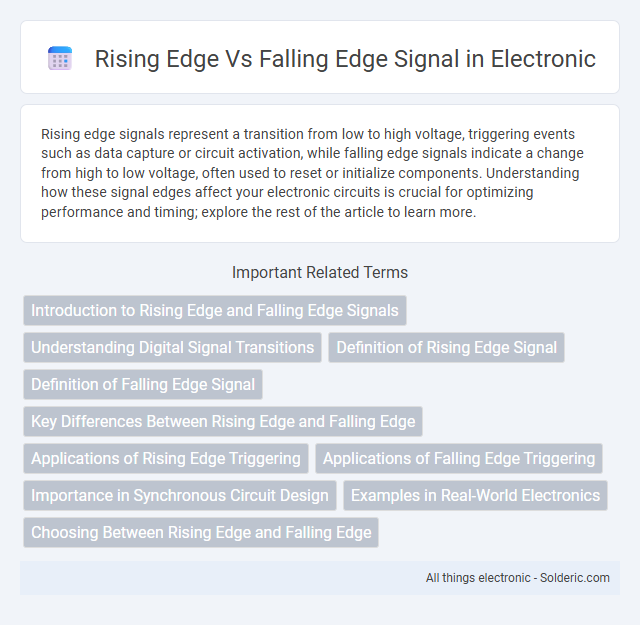Rising edge signals represent a transition from low to high voltage, triggering events such as data capture or circuit activation, while falling edge signals indicate a change from high to low voltage, often used to reset or initialize components. Understanding how these signal edges affect your electronic circuits is crucial for optimizing performance and timing; explore the rest of the article to learn more.
Comparison Table
| Feature | Rising Edge Signal | Falling Edge Signal |
|---|---|---|
| Definition | Transition from low (0) to high (1) voltage level | Transition from high (1) to low (0) voltage level |
| Trigger Event | Occurs on upward voltage change | Occurs on downward voltage change |
| Common Use | Used for clocking, data sampling, and synchronization | Used for similar applications, often to avoid timing conflicts |
| Signal Timing | Signals active at rising voltage transition | Signals active at falling voltage transition |
| Timing Sensitivity | May be prone to noise during voltage climb | May be susceptible to glitches during voltage drop |
| Examples | Clock rising edge triggering flip-flops | Negative edge triggered counters or flip-flops |
Introduction to Rising Edge and Falling Edge Signals
Rising edge signals occur when a digital waveform transitions from a low logic level (0) to a high logic level (1), marking the moment a signal starts or activates. Falling edge signals represent the opposite transition, moving from a high logic level (1) down to a low logic level (0), often indicating the end or deactivation of a pulse. Understanding these signal edges is crucial for timing analysis, triggering events, and designing reliable digital circuits and systems.
Understanding Digital Signal Transitions
Digital signal transitions occur at either the rising edge, where the signal changes from low to high, or the falling edge, where it shifts from high to low. Understanding these transitions is crucial in timing-sensitive applications like clocking circuits and data sampling, as each edge can trigger distinct actions in your digital system. Accurate detection of rising and falling edges ensures reliable performance and synchronization in digital electronics.
Definition of Rising Edge Signal
A rising edge signal refers to the transition of a digital signal from a low voltage level (logic 0) to a high voltage level (logic 1). This change is critical in digital circuits for triggering events such as clock pulses, data capture, and synchronization. Detection of rising edges enables precise timing control in microprocessors, flip-flops, and other sequential logic devices.
Definition of Falling Edge Signal
A falling edge signal refers to the transition of a digital signal from a high voltage level to a low voltage level, marking the downward edge of a waveform. This transition is critical in digital electronics for triggering events or synchronizing circuits. Understanding the timing of the falling edge allows you to accurately control and respond to changes in signal states in your digital systems.
Key Differences Between Rising Edge and Falling Edge
Rising edge signals transition from low to high voltage, while falling edge signals change from high to low voltage, defining the key difference in signal triggering. Rising edges often initiate events like clock pulses in digital circuits, whereas falling edges are used to trigger actions or capture data at the transition from high to low state. Timing analysis in electronic design emphasizes these differences, impacting synchronization and signal integrity in systems like microcontrollers and communication interfaces.
Applications of Rising Edge Triggering
Rising edge triggering is widely used in digital circuits to detect the transition from low to high voltage, enabling precise timing control in microprocessors and flip-flops. It is essential in applications such as clocking in synchronous systems, where it ensures data is latched at the exact moment the clock signal rises. This method enhances signal integrity and reliability in communication interfaces and timing-critical embedded systems.
Applications of Falling Edge Triggering
Falling edge triggering is widely used in digital electronics for applications requiring precise timing when a signal transitions from high to low, such as in flip-flops, counters, and shift registers. This method ensures reliable synchronization by capturing data exactly at the moment the clock signal drops, minimizing timing errors in microcontrollers and communication interfaces. Understanding how falling edge triggering works can enhance your system's performance by providing stable, noise-immune control in sequential logic circuits.
Importance in Synchronous Circuit Design
Rising edge and falling edge signals serve as critical timing references in synchronous circuit design, determining when data is captured or transferred within flip-flops and registers. Accurate detection of these edges ensures precise synchronization of sequential elements, minimizing setup and hold time violations that can lead to data corruption. Optimizing edge-triggering mechanisms enhances circuit speed, reliability, and overall performance in digital systems.
Examples in Real-World Electronics
Rising edge signals trigger actions such as starting timers or capturing data in microcontrollers, commonly seen in clock pulses for synchronous circuits. Falling edge signals activate processes like resetting flip-flops or interrupting a microprocessor to ensure timely responses in devices like digital watches and communication systems. Understanding how your circuit interprets these edges helps optimize signal timing and improves overall system reliability.
Choosing Between Rising Edge and Falling Edge
Choosing between rising edge and falling edge signals depends on the specific timing requirements and circuit design in digital electronics. Rising edge triggering initiates actions when the signal transitions from low to high, making it suitable for synchronous events with positive logic. Falling edge triggering occurs when the signal changes from high to low and is preferred in scenarios where negative logic or specific timing constraints enhance circuit stability and noise immunity.
rising edge vs falling edge signal Infographic

 solderic.com
solderic.com